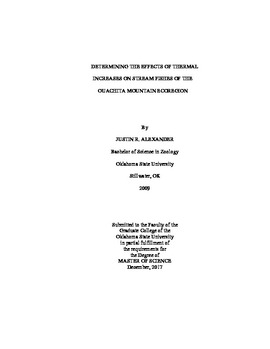| dc.description.abstract | Altered thermal regimes affect stream fishes both directly and indirectly, influencing their distribution, growth, reproduction, and survival. Increasing temperatures and growing demand for freshwater highlight the need to predict stream fish responses to increasing stream temperatures; however, we lack information on the thermal tolerances of many warmwater stream fishes. The objectives of my thesis were to 1) determine critical thermal maxima (CTMax) of 10 stream fishes in the Ouachita Mountain ecoregion, and 2) assess stress response by six stream fishes via whole-body cortisol after prolonged exposure to elevated water temperatures. First, I determined CTMax for 10 stream fishes of the Ouachita Mountain ecoregion (20°C acclimation, 2°C per h heating rate). Critical thermal maxima ranged 34.0-38.3°C among species. Blackspotted Topminnow Fundulus olivaceus had the highest CTMax and Orangebelly Darter Etheostoma radiosum and Channel Darter Percina copelandi had the lowest CTMax. Benthic fishes had the lowest CTMax, and the only surface-dwelling species tested had the highest CTMax. The CTMax values determined in my study are useful for developing proactive conservation and management strategies aimed at maintaining or improving stream-thermal conditions, and predicting species most susceptible to thermal change. Lastly, I measured whole-body cortisol concentrations of six stream fishes of the Ouachita Mountain ecoregion after prolonged exposure to elevated water temperatures. I acclimated fishes to 20.0°C, increased temperature 1°C per d, and exposed fishes to treatment temperatures (control, 27.0°C; experimental, 32.0°C) for 14-d. I hypothesized that fishes exposed to 32.0°C would show increased whole-body cortisol concentrations and that levels of stress response would relate to thermal sensitivity (i.e., CTMax, Chapter 2). I found no significant differences in stress response by fishes between the two treatment temperatures. Results from my stress trials represent basal whole-body cortisol concentrations for all my study species except Highland Stoneroller Campostoma spadiceum. Despite apparent tolerance of, or acclimation to, stressful thermal conditions, fishes may suffer from decreased reproduction or growth; thus, future studies should investigate the tertiary stress response to chronic thermal stress in these species. Whole-body cortisol levels from this study may serve as a baseline for monitoring stress in small-bodied stream fishes inhabiting altered stream systems. | |
